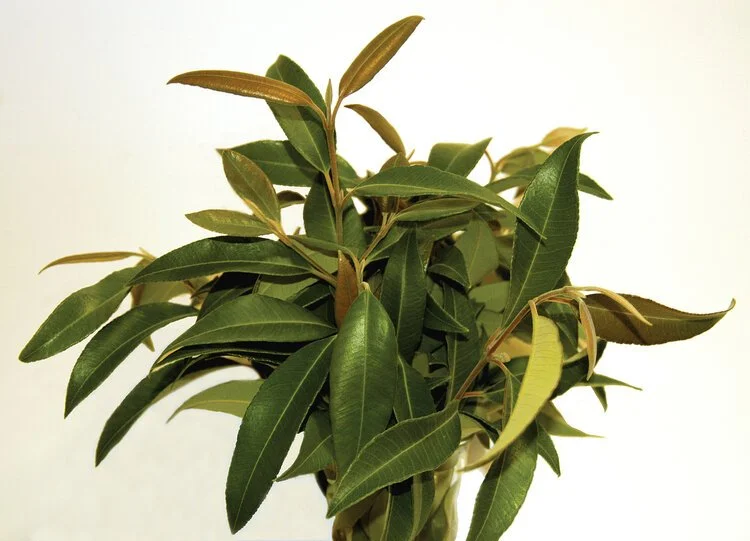5 Essential Oils to Reduce Inflammation: with remedies for inflammation due to stress, anxiety, fear, depression and the respiratory virus “cytokine storm.”
There are some extraordinary essential oils that can reduce inflammation and pain, and protect from the degenerative and oxidative damage inflammation may cause. Helichrysum italicum, copaiba (Copaifera langsdorffii), ginger (Zingiber officinalis), patchouli (Pogostemon cablin) and turmeric (Curcuma longa) are 5 of the most potent essential oils to reduce systemic inflammation. These oils can be combined with other good anti-inflammatory oils and designed to address specific causes of inflammation. When inflammation is due to viral respiratory cytokine release (“cytokine storm”), the antiviral and anti-inflammatory oils patchouli, tea tree (Melaleuca alternifolia) and Eucalyptus globulus would be a potent remedy. Lavender (Lavandula angustifolia), bergamot (Citrus aurantium bergamia), and Virginia cedarwood (Juniperus virginiana) are just a few of the oils that would work in an anti-inflammatory blend with a focus on also diminishing anxiety or stress.
INFLAMMATION
Inflammation is a function of the body’s defensive immune response to injury, pathogenic infection and environmental triggers. Acute inflammation is the immediate response to the condition or pathogen and will resolve itself when the threat to the body is complete. Chronic inflammation has become a common malady and is said to be a leading cause of many illnesses, disease and aging. This type of long-standing inflammation may be due to several factors that would include viral infection, stress, environmental stressors, poor lifestyle or diet, and ongoing conditions such as asthma, Crohn’s disease and rheumatoid arthritis.
Inflammation is a function of the body’s defensive immune response to injury, pathogenic infection and environmental triggers
SIGNS OF INFLAMMATION
Acute inflammation is visible by way of redness and swelling and may include pain, heat and loss of movement. This is due to the vasodilation and permeability of the blood vessels, which allows for the increased blood flow to the area and introduction of defensive substances. Chronic inflammation may not show obvious signs and is generally systemic, can go on throughout the body, and may be silently causing damage to the cardiovascular, digestive, integumentary (skin) and respiratory systems, along with cellular damage.
INFLAMMATORY COMPOUNDS COX-2 AND CYTOKINES
The body’s reaction to infection and injury includes the release of histamine, kinins, prostaglandins, complements and leukotrienes. These categories of substances form the healing mechanisms of the inflammatory response. It’s when these inflammatory compounds are prolonged or exaggerated that they become damaging to the body, as well as potentially slowing a healing response. One of the most ominous of inflammatory compounds are the cytokines. You’ll see these referenced often as the “cytokine storm” that has the damaging effect on the body. The cytokine storm is related to the serious lung inflammation resulting from respiratory viral infection that potentially may cause pneumonia and death.
Cyclooxygenase-2 (COX-2) initiates the inflammatory response triggering production of cytokines, chemokines and proinflammatory prostaglandins (Chu Chen, 2010). Most people are familiar with the use of Ibuprofen and aspirin to reduce inflammation and fever. These drugs are COX-2 inhibitors, which is the way they reduce inflammation.
Citral, a lemony scented compound, suppresses COX-2 expression (Michiko Katsukawa, et al, 2010). This would point to the use of lemongrass (Cymbopogon citrates or flexuosus), lemon myrtle (Backhousia citriodora) and Litsea cubeba as good anti-inflammatory oils. These are also potent anti-viral essential oils and would be recommended for treatment of viral respiratory lung infection.
Citral, a lemony scented compound, suppresses COX-2 expression
ESSENTIAL OILS FOR ACUTE INFLAMMATION
Helichrysum is an excellent first aid when applied at the time of injuries such has tendon strain or impact trauma. Helichrysum in combination with peppermint (Mentha piperita) and Kunzea ambigua would be a potent blend to offer quick relief and healing of these injuries. The oils are used to mediate the inflammatory response and will help reduce edema. Helichrysum and peppermint are often recommended to prevent excessive bruising due to impact injury when applied soon after the incident.
These essential oils, along with other good anti-inflammatory oils like copaiba, clove (Eugenia caryophyllata), cumin (Cuminum cyminum), and Eucalyptus radiata, can be used in topical lotions to treat the condition until the inflammation has diminished.
STRESS, ANXIETY AND INFLAMMATION
The negative effects on the body due to stress, fear and anxiety are many, including inflammation. There is experimental evidence showing that different types of psychosocial stressors increase systemic and central nervous system levels of pro-inflammatory cytokines. Psychological stress-induced distress and anxiety showed significantly greater increases in the inflammatory markers (Berk, et al, 2013).
The “fight or flight” response, turned on at times of high anxiety, stress or fear, is the body’s response to danger. This is great if being chased by a bear, though not a good thing if you’re stuck in traffic or freaking out over an interview. The response, simplistically, is the sympathetic nervous system in overdrive, releasing adrenaline, raising heart rate, quickening the breath and slowing digestion. This is a cause of damage, disease or imbalance to the cardiovascular, respiratory or digestive systems. The damage caused could be a source of inflammation as well, where the cycle of imbalance continues.
Many recommendations are made for creating equilibrium in this area, which would include meditation, self-help philosophies and essential oils. Marjoram (Origanum majorana), Virginia cedarwood and hinoki wood (Chamaecyparis obtusa) are some of the best essential oils shown to raise parasympathetic activity, or reduce fight or flight (Samantha Dayawansa, et al 2003; Harumi Ikei, et al 2016).
The negative effects on the body due to stress, fear and anxiety are many, including inflammation.
INFLAMMATION AND DEPRESSION
There have been reports that Covid-19, the global pandemic at the time of this writing, has a symptom of depression or similar emotional turmoil. In reviewing studies there is connection between depression and inflammation (Felger, Jennifer C, 2018). The link suggests inflammation to be a mediating pathway to risk of, and neuroprogression in, depression (Berk, et al, 2013). This would suggest that the reported emotional impact of Covid-19 is related to the inflammation caused by the viral infection.
A key point to this awareness, for those with depression or similar emotional distress, is to check inflammatory markers or at least begin a diet, supplementation and essential oil protocol to address chronic inflammation.
HOW DO THE ESSENTIAL OILS WORK TO REDUCE INFLAMMATION?
There are known mechanisms in the way that essential oils resolve inflammation. In a study by Yun Jeong Kim, they saw the “downregulated expression of IL-6, TNF-[alpha] and COX-2 in HEKa cells. In addition, the inhibition of TNF-[alpha] and NO production further confirms the anti-inflammatory effects of Helichrysum bracteatum flower extracts” (Yun Jeong Kim et al, 2019). This helichrysum studied is not the Helichrysum italicum commonly used in aromatherapy with the common names of helichrysum, immortelle and everlast.
The study is a good example of the anti-inflammatory effects of many oils studied, including Helichrysum italicum. IL-6 and TNF-[alpha] are cytokines, the group of proteins already acknowledged as responsible for inflammation. In this study, NO refers to inducible nitric oxide synthase, an enzyme released in the immune response producing nitric oxide as a defense.
Β-CARYOPHYLLENE AND ⍺-HUMULENE (SYNONYM ⍺-CARYOPHYLLENE)
Two compounds that were seen having strong anti-inflammatory action in a 2007 study are β-caryophyllene and ⍺-humulene (Elizabeth S Fernandes et al, 2007). The compounds were derived from Cordia verbenacea (common name black sage), a South American bush whose essential oil is rarely found in the market. There are several other essential oils that contain therapeutic anti-inflammatory amounts of the these compounds like copaiba, black pepper (Piper nigrum), Madagascan ylang ylang (Cananga odorata), hops (Humulus lupulus) and hemp (Cannabis sativa or indica).
CHRONIC INFLAMMATION
The best approach to reducing chronic inflammation is through dietary choices and reduction of stress. If environment or food sensitivity is the cause of chronic inflammation, these must be found and resolved prior to beginning any therapeutic protocol. The ideal anti-inflammatory foods are from the rainbow diet, eating colorful fruits and vegetables daily, along with spices and omega-3 fatty acids, which can be consumed as supplements. Anti-inflammatory spices are cardamon, ginger, turmeric and galangal.
The anti-inflammatory essential oils would be used as an adjunct treatment to the diet. Use essential oils that address the potential causes of chronic inflammation, such as stress reducing essential oils, lavender, bergamot and clary sage (Salvia sclarea), that ease emotional anxiety and relieve the inflammation caused by stress and anxiety.
References
Li, Yu-Cui, et al. “Oral Administration of Patchouli Alcohol Isolated from Pogostemonis Herba Augments Protection Against Influenza Viral Infection in Mice.” International Immunopharmacology, vol. 12, no. 1, Elsevier B.V, 2012, pp. 294–301
Gandhi, Gopalsamy Rajiv, et al. “Essential Oils and Its Bioactive Compounds Modulating Cytokines: A Systematic Review on Anti-Asthmatic and Immunomodulatory Properties.” Phytomedicine : International Journal of Phytotherapy and Phytopharmacology, Jan. 2019, pp. 152854–152854
Iannarelli, Romilde, et al. “Aniseed (Pimpinella Anisum L.) Essential Oil Reduces Pro-Inflammatory Cytokines and Stimulates Mucus Secretion in Primary Airway Bronchial and Tracheal Epithelial Cell Lines.” Industrial Crops & Products, vol. 114, Elsevier B.V, Apr. 2018, pp. 81–86
Nam, Sang-Yun, et al. “Essential Oil of Niaouli Preferentially Potentiates Antigen-Specific Cellular Immunity and Cytokine Production by Macrophages.” Immunopharmacology and Immunotoxicology, vol. 30, no. 3, Jan. 2008, pp. 459–74
Horváth, G., and Ács, K. ( 2015) Essential oils in the treatment of respiratory tract diseases highlighting their role in bacterial infections and their anti‐inflammatory action: a review. Flavour Fragr. J., 30: 331– 341.
Felger, Jennifer C. “Imaging the Role of Inflammation in Mood and Anxiety-Related Disorders.” Current Neuropharmacology, vol. 16, no. 5, Bentham Science Publishers Ltd., 2018, pp. 533–58
Berk M, Williams LJ, Jacka FN, et al. So depression is an inflammatory disease, but where does the inflammation come from?. BMC Med. 2013;11:200. Published 2013 Sep 12.
Fernandes, Elizabeth S., et al. “Anti-Inflammatory Effects of Compounds Alpha-Humulene and (-)-Trans-Caryophyllene Isolated from the Essential Oil of Cordia Verbenacea.” European Journal of Pharmacology, vol. 569, no. 3, Aug. 2007, pp. 228–36
Kim, Yun Jeong, et al. “Effects of Helichrysum Bracteatum Flower Extracts on UVB Irradiation-Induced Inflammatory Biomarker expression.(Report).” Biomedical Dermatology, vol. 3, no. 1, Springer, Dec. 2019, pp. 1–6
Chu Chen. “Lipids: COX-2’s New Role in Inflammation.” Nature Chemical Biology, vol. 6, no. 6, Nature Publishing Group, June 2010, pp. 401–02,.
Katsukawa, Michiko, et al. “Citral, a Component of Lemongrass Oil, Activates PPARα and γ and Suppresses COX-2 Expression.” BBA - Molecular and Cell Biology of Lipids, vol. 1801, no. 11, Elsevier B.V, 2010, pp. 1214–20,
Sun, Zhenliang, et al. “Chemical Composition and Anti-Inflammatory, Cytotoxic and Antioxidant Activities of Essential Oil from Leaves of Mentha Piperita Grown in China.” PLoS ONE, vol. 9, no. 12, Public Library of Science, Dec. 2014, p. e114767
Ikei, Harumi, et al. “Effects of Olfactory Stimulation by α-Pinene on Autonomic Nervous Activity.” Journal of Wood Science, vol. 62, no. 6, Springer Japan, Dec. 2016, pp. 568–72



